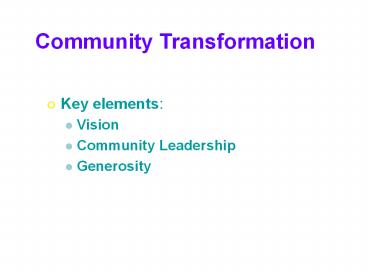Key elements: - PowerPoint PPT Presentation
1 / 29
Title:
Key elements:
Description:
access to the system - housing, water, schools, electricity, roading ... DDT had also killed a parasitic wasp which controlled thatch-eating caterpillars. ... – PowerPoint PPT presentation
Number of Views:256
Avg rating:3.0/5.0
Title: Key elements:
1
Community Transformation
- Key elements
- Vision
- Community Leadership
- Generosity
2
Community Transformation - Southern India
- Untouchable - Dalit people
- 20 of Indias population
- below the bottom rung of the caste system
- two-thirds illiterate and landless
- discriminated against
- denied legal rights, beaten up
3
Community Transformation - Southern India
- Untouchable Occupations
- wood gatherers
- quarry workers
- scavengers
- handle dead bodies
- night cart operators
- bonded labour
4
(No Transcript)
5
(No Transcript)
6
(No Transcript)
7
Community Transformation - Southern India
- Womens Development Resource Centre
- works with women, families communities
- supports communities to take action
- supports communities learning from experience,
and leading change themselves
8
Community Transformation - Southern India
- Impact
- access to the system - housing, water, schools,
electricity, roading - building wealth - micro-credit, and credit union
- Women Labourers Bank for enterprise
development - participating in society - 300 women stood for
local government at the end of 2006, literacy
levels increased - Now We Are Fearless
9
Community Transformation - Southern India
- Key elements
- vision
- authentic voices at the heart of community
- whole community - landlords, local government
- collaboration
- systems change for lasting impact
10
Community Transformation - Southern India
- To achieve sustainable change communities have
- partnered with land owners, city and state
government, businesses, trade unions - built a movement for change
11
Community Transformation - Southern India
- Funder
- has been supporting for ten years
- supported and resourced communities to work at
their own pace and with own priorities - supported sytems change for lasting impact
- helped make connections with others on a similar
path - shared the vision
12
Community - Southern New Zealand
13
(No Transcript)
14
(No Transcript)
15
(No Transcript)
16
(No Transcript)
17
(No Transcript)
18
The people of the Waiau Valley
- 2001 census 1,326 people
- 1996 census 1,550 people
- 1996 census 11 Mäori
19
(No Transcript)
20
Voluntary work in Waiau Valley (source MAF 1998)
- 82 of population involved in voluntary work
- An average of 533 hours voluntary work per person
per year - 93 community groups to be sustained by fewer than
1,550 people
21
The legacy of the 1980s -1990s
- The demise of the forestry industry
- The centralisation of government services
- The closure of post offices, banks, schools etc
- The removal of managers professionals, and
their skills - The increase in farm size
- The increase in off-farm employment (esp. for
farm women) - A declining population
- Means fewer people with less time each
22
Waiau Valley community groups
- Voluntary work in this community is responsible
for - The local schools, via BOTs, PTA, etc
- Provision of a medical and hospital trust
- Emergency services such as Fire, Ambulance,
Search and Rescue, Community First Response - Community facilities such as halls and
playgrounds - Community Board decisions on rates and other
Council issues - Sports, arts and recreation and their social and
health benefits - Economic initiatives such as scenic routes and
the Hump Ridge Track
23
(No Transcript)
24
And what of the Waiau communitys future?
- Failing community infrastructure
- Closure of services
- Increasing social fragmentation
- People living in disconnected isolation
- Ghetto phenomenon of poverty and
disenfranchisement in rural towns - Continuing depopulation
- Young people seen as a problem and at risk
25
Or
- Resilient vibrant community
- Sound community infrastructure
- Social cohesion and connectedness
- New enterprises contributing to healthy economy
- Opportunities for young people to achieve their
potential
26
The role of philanthropy?
- Philanthropy can support community by
- Taking care to build rather than undermine the
social capital in a community - Making things easier (not harder)
- Contributing vision and generosity
- Offering advocacy and support
- Listening to the Authentic Voices
- Fostering collaboration
- Facilitating useful links to the wider picture
27
(No Transcript)
28
- In the absence of concrete support for the
complex human process of engaging with, and
mobilising communities, the new philanthropists
may find that the lofty goals they have set
themselves are beyond their reach. - New York Review
- February 15,2007
29
- Parachuting cats into Borneo!
- In the early 1950s, the Dayak people of Borneo
suffered an outbreak of malaria. The World
Health Organisation (WHO) had a solution to
spray large amounts of DDT to kill the mosquitoes
that carried the malaria. The mosquitoes died.
The malaria declined so far so good. But there
were unexpected side effects. Early on peoples
roofs began to fall down on their heads. It
seems the DDT had also killed a parasitic wasp
which controlled thatch-eating caterpillars.
Worse, the DDT-poisoned insects were eaten by
geckoes. The gekoes were eaten by cats. The
cats started to die, the rats flourished, and the
people were threatened by outbreaks of typhus and
plague. To cope with these problems, which it
had itself created, the WHO was obliged to
parachute 14,000 live cats into Borneo.
Operation Cat Drop, now almost forgotten at the
WHO, is a graphic illustration of the
interconnectedness of life, the importance of
starting with community knowledge and creating
collaborative solutions and what happens if you
dont. - www.cdra.org.za































